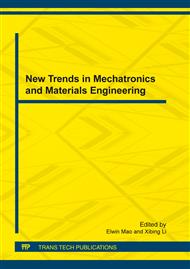p.392
p.396
p.401
p.409
p.414
p.419
p.424
p.429
p.433
Optimization Design of a Hyperbolic Flexure Hinge Based on its Closed-Form Equations
Abstract:
An optimization design method of a hyperbolic flexible hinge is presented in this paper. According to the structure feature and force exerted on the flexible hinge, the closed-form equations are formulated for compliances to characterize both the active rotation and all other in- and out-of-plane parasitic motions by using the Castigliano’s second theorem. Meanwhile, the accuracy equations of the hyperbolic flexure hinge are obtained using the Castigliano’s second theorem. The in-plane rotation angle of flexure hinge is optimization objective, and the constraints of optimization model are out-of-plane displacements and one described the accuracy of hinge, such that the optimization model can be established to meet performance requirements of flexure hinge. Based on the optimization model, the optimization designs of hyperbolic flexure hinge are performed to acquire its optimized structural parameters. And the optimization results have showed the optimization process can meet the design requirement.
Info:
Periodical:
Pages:
414-418
Citation:
Online since:
January 2012
Authors:
Price:
Сopyright:
© 2012 Trans Tech Publications Ltd. All Rights Reserved
Share:
Citation:


